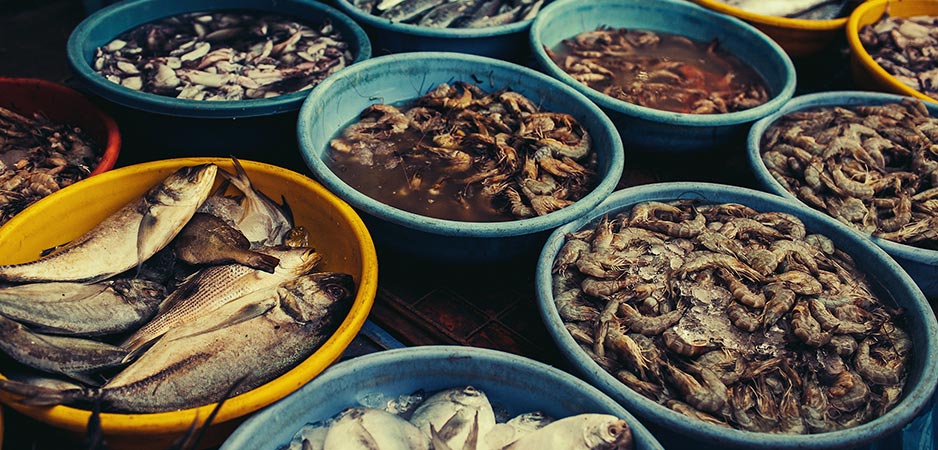Around the world, the news agenda is dominated by the coronavirus and the policy responses to it. Naturally, most of the attention is paid to things like how many people are dying and when the various lockdowns can be lifted. However, in every industry, there is a story to be told about the impact of the virus and the ensuing economic disruption, and it is in this detail that we find the true effects on people’s lives. A case in point is the shrimp industry, and as a former secretary of animal husbandry, dairying and fisheries in India, this is a matter close to my heart.
Fish, and this includes shrimp, is India’s single biggest export amongst all agricultural commodities. Within this broad category, shrimp is the most dominant product. About 90% of our shrimp produce is exported, the major destinations being the US, China and the European Union. With the coronavirus pandemic having hit the entire world, our major export markets are all but shut. At this stage, no reasonable assessment can be made as to if and when these markets would be accessible again.
Has COVID-19 Launched a New Era of Deadly Pandemics?
To most people, the fate of the Indian shrimp market is probably not a matter of daily concern. However, nearly 3 million people are engaged in activities directly tied to this industry. These people face a looming disaster.
While the coronavirus has adversely impacted all sectors of our economy, the negative impact is more severe in fisheries and aquaculture. By its very nature, the product’s harvest has to follow a biological cycle, it is highly perishable and cannot be stored over a long period of time.
During the last decade, India has come to dominate the frozen shrimp market by emerging as its biggest exporter. We command 24.9% of the frozen shrimp market while Ecuador comes second with a 21.1% share. Remarkably, shrimp exports stood at $4.6 billion in the year 2018-19 and accounted for 70% of the total value of Indian fish exports. As a result, shrimp aquaculture, along with its supporting and allied activities, has come to play a dominant role in the economies of the coastal states of India. The coronavirus pandemic has devastated this once thriving industry.
What has compounded the misery of shrimp aquaculturists is the timing of the calamity. February and March are the peak months for the stocking of seed in farms and ponds. Therefore, the hatcheries are at their peak of production during this period. If this was not bad enough, in certain areas, the stocking schedule has been pushed back to March/April on account of an extended winter.
Lockdown in India
The timing could not have been worse. The initial period of the coronavirus lockdown in India disrupted the supply chains all across the country. As a result, farmers lost out on seed procurement and the hatcheries got saddled with stocks without any buyers. Where the farmers managed to procure and stock the seed before the lockdown was enforced on March 25, they ran into the problem of obtaining feed, which seriously impaired the farming activity.
It is true that the trade of fish and shrimp is exempt from the lockdown, but news of this took far too long to percolate down to authorities on the ground. Moreover, such exemptions and their implementation are not able to address the complexities of the production and supply chain, such as the regular requirement of ice, farming equipment, food supplements, fishmeal and so forth. None of these find a specific mention in the regulations. The shrimp supply chain is complex and time-sensitive, and regulations that do not account for that have a deeply destabilizing impact.
It is not just what happens in India that will determine the fate of the Indian shrimp industry. Even after having attained global leadership in the shrimp trade, paradoxically we are wholly dependent upon the import of broodstock for the production of seed for farming. Interestingly, our major destination of exports also happens to be our main source of import of broodstock, the United States. Nearly 80% of the brooders are sourced from Hawaii and Florida.
If trade does not resume full swing in the next 30 days or so, our hatcheries will not be in a position to produce seed for the next season of stocking, and the farmers will have little choice but to dry up their ponds. This will result in Indians involved in the shrimp industry losing their livelihoods and consumers around the world not being able to enjoy the wonderful shrimp we produce over the years to come.
These are desperate times calling for desperate measures. If such changes are not introduced immediately, even a nudge of support here and there would help this resilient industry tide over the crisis. To begin with, the government, through the Marine Products Exports Development Authority (MPEDA) or any other agency, could coordinate, facilitate and perhaps integrate the produce of all our farmers. It could also make special arrangements for the transportation of produce to the most important international markets. Not only would this take care of the product and its value realization, but it would also alleviate the panic and anxiety of the stakeholders.
Moreover, some quick interventions could be taken without much difficulty. These include seven policies. First, the government could tweak the guidelines of aquatic quarantine to ease import and licensing conditions. Second, it could automatically renew hatchery and farm licenses to avoid further disruption. Third, the government could provide easy access to credit for the next crop. Fourth, instituting insurance coverage for producers would be a sensible policy. Fifth, a reduction in import duty for fish and shrimp feed, Artemis cyst, food supplements and equipment would support an industry that brings in export revenue. Sixth, financial incentives should go directly to the primary producer instead of flowing through an exporter. Finally, some subsidy on fish and shrimp feed, which is the major variable cost in shrimp farming and hatchery operations, would help producers tide over short-term pain and return to good health when market conditions change.
Saving an Industry
The interventions above would help the shrimp industry tide over an unprecedented crisis. In the mid to long term, we must seriously give thought to this simple fact that our biggest agriculture export gets the least financial support or incentives in our policies and schemes. Shrimp farming is considered neither agriculture nor an industrial enterprise, thus it receives no benefits from the government. As a successful industry, it has been able to stand on its own two feet until now. Now, it needs support.
India must give aquaculture the same benefits and incentives it gives to crop farming. This would further propel our shrimp production and encourage investment in creating our own breeding facilities. In turn, this would reduce our dependence on imports for the primary input, the broodstock. Most importantly, in the long run, it would serve the sector well if we shelve our obsession with exports and make efforts to develop the huge domestic market, which the world is eyeing but our own shrimp industry has ignored. Surely, it would be more convenient and cheaper to transport shrimp from Vishakhapatnam to Delhi or Indore than to the US and China. A simple Google search would reveal that shrimp prices in the Delhi market are as good if not higher than in London or New York.
The story of India’s shrimp aquaculture over the last decade is one of triumph over adversity. The industry faced near closure in the early 2000s on account of the White Spot Syndrome Virus, a shrimp pandemic that led to the closure of 50% to 80% of hatcheries and farms. The introduction of the disease-resistant shrimp Litopenaeus Vannamei revolutionized the sector.
We now boast of an infrastructure of more than 550 shrimp hatcheries feeding 160,000 hectares of farming and generating a production of nearly 800,000 tons. Ten years ago, in 2008-09, our production was a mere 76,000 tons. Little wonder, shrimp has emerged as the leader of India’s agriculture exports, generating prosperity for the people involved in farming, hatchery and processing operations and allowing them to live their dreams. The White Spot Syndrome Virus could not shatter these dreams. Let’s not allow the coronavirus to do so either.
The views expressed in this article are the author’s own and do not necessarily reflect Fair Observer’s editorial policy.
Support Fair Observer
We rely on your support for our independence, diversity and quality.
For more than 10 years, Fair Observer has been free, fair and independent. No billionaire owns us, no advertisers control us. We are a reader-supported nonprofit. Unlike many other publications, we keep our content free for readers regardless of where they live or whether they can afford to pay. We have no paywalls and no ads.
In the post-truth era of fake news, echo chambers and filter bubbles, we publish a plurality of perspectives from around the world. Anyone can publish with us, but everyone goes through a rigorous editorial process. So, you get fact-checked, well-reasoned content instead of noise.
We publish 2,500+ voices from 90+ countries. We also conduct education and training programs
on subjects ranging from digital media and journalism to writing and critical thinking. This
doesn’t come cheap. Servers, editors, trainers and web developers cost
money.
Please consider supporting us on a regular basis as a recurring donor or a
sustaining member.
Will you support FO’s journalism?
We rely on your support for our independence, diversity and quality.






